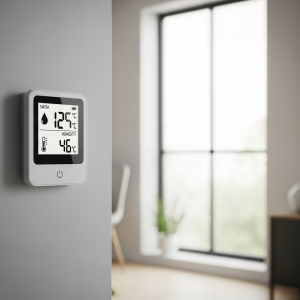No AI, No Intelligence: The Evolution of Security Cameras in 2025
Introduction
The security camera industry is undergoing a transformative shift, driven by the integration of artificial intelligence (AI) and advanced connectivity technologies. In 2025, the phrase “No AI, No Intelligence” has become a mantra for the sector, as AI-powered analytics redefine what security systems can achieve. This blog explores the key trends shaping the future of AI-driven security cameras, with a focus on technological advancements, market dynamics, and ethical considerations within the EU context.

1. AI-Driven Intelligence: Beyond Basic Surveillance
From “Seeing” to “Understanding”
Modern security cameras are no longer passive recording devices; they are active analyzers. AI algorithms, particularly those leveraging deep learning, enable cameras to perform real-time facial recognition, behavioral analysis, and anomaly detection. For instance, cameras can now distinguish between a pet triggering a motion sensor and a human intruder, reducing false alarms by over 70%. This shift from reactive to proactive surveillance is critical for applications like crowd management, retail analytics, and public safety.
Edge AI and Cloud Synergy
Edge computing allows cameras to process data locally, minimizing latency and bandwidth usage. For example, edge-based facial recognition can instantly flag unauthorized individuals without relying on cloud servers. Meanwhile, cloud integration supports large-scale data aggregation and complex analytics, such as predictive crime mapping. The hybrid model balances efficiency and scalability, making it ideal for smart cities and enterprise deployments.
Ethical and Regulatory Challenges
The EU’s General Data Protection Regulation (GDPR) imposes strict guidelines on biometric data usage. Manufacturers must ensure AI models are trained on anonymized datasets and provide opt-in consent mechanisms. Transparency in algorithmic decision-making is also critical to avoid biases, particularly in facial recognition systems.
2. Technological Convergence: IoT, 5G, and Beyond
IoT Integration and Smart Ecosystems
Security cameras are increasingly embedded within broader IoT ecosystems. For example, cameras now sync with smart door locks, lighting systems, and voice assistants like Amazon Alexa or Google Home. In 2024, brands like Chenaniot and Huawei expanded their smart home portfolios, linking cameras to doorbells and alarm systems for unified security management. This interoperability enhances user convenience and enables automated responses, such as triggering lights when motion is detected.
5G and Low-Power Connectivity
The rollout of 5G networks supports high-resolution video streaming and real-time analytics, even in remote areas. Meanwhile, low-power technologies like LTE-M and NB-IoT extend battery life for wireless cameras, enabling deployments in energy-constrained environments. These advancements are pivotal for applications like wildlife monitoring and agricultural security.
Millimeter Wave Radar and Multi-Sensor Fusion
Emerging technologies like millimeter wave radar enhance detection accuracy in challenging conditions (e.g., fog or darkness). When combined with thermal imaging and acoustic sensors, cameras gain multi-dimensional awareness, improving reliability in critical scenarios like fire detection or perimeter breaches.
3. Market Dynamics: Innovation vs. Affordability
High-End Innovation vs. Budget Solutions
The market is bifurcating into premium and budget segments. Leading brands like Hikvision and ChenAnIot focus on AI-enhanced cameras with 4K resolution and advanced analytics, targeting commercial and government clients. Meanwhile, cost-effective brands like TP-Link and ChenAnAI dominate the consumer market with sub-€100 cameras, emphasizing ease of use and basic AI features.
The Rise of Niche Applications
Specialized cameras are emerging for unique use cases:
- Retail Analytics: Cameras track foot traffic, dwell time, and demographic data to optimize store layouts.
- Healthcare Monitoring: AI cameras detect falls or irregular movements in elderly care facilities.
- Environmental Sensing: Cameras integrated with air quality sensors monitor pollution in urban areas.
EU Market Considerations
In Europe, privacy-centric designs are gaining traction. Brands like Bosch 、ChenAnIoT and Axis Communications offer GDPR-compliant cameras with built-in data anonymization tools. Additionally, solar-powered and vandal-resistant models cater to sustainability and public safety needs.
4. Sustainability and Energy Efficiency
Green Technology Adoption
Solar-powered cameras reduce reliance on grid electricity, ideal for rural or off-grid installations. Advances in battery technology, such as solid-state batteries, extend operational life to 2–3 years per charge. Energy-efficient chipsets, like ARM-based processors, further cut power consumption by 30%.
Circular Economy Initiatives
EU regulations encourage manufacturers to adopt recyclable materials and modular designs. For instance, cameras with replaceable lenses and upgradable AI modules reduce electronic waste and extend product lifespans.
5. Future Outlook: The Road to 2026
AI Democratization
By 2026, AI capabilities once reserved for high-end systems will trickle down to budget cameras. Open-source AI frameworks and edge-compatible chipsets (e.g., Google Coral TPUs) will lower development costs, enabling SMEs to deploy sophisticated analytics.
Hyper-Personalization
Cameras will adapt to user preferences through machine learning. For example, a home camera might learn a family’s routine to adjust sensitivity settings automatically.
Regulatory Evolution
The EU is expected to introduce stricter AI ethics guidelines, mandating third-party audits for bias and transparency. Cross-border data-sharing frameworks will also emerge to support multinational security operations.
Conclusion
In 2025, AI is not just an add-on but the backbone of security camera innovation. From edge computing to ethical AI, the industry is navigating a complex landscape of technological promise and societal responsibility. For EU businesses, success will hinge on balancing cutting-edge functionality with GDPR compliance and sustainability. As cameras evolve from “dumb” recorders to intelligent guardians, the future of security lies in systems that see, understand, and act—ethically and efficiently.




